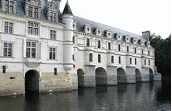|
Some of the oldest of the vineyards are those of Hermitage and
Cote Rotie, and one of the vineyards which was taken over by the monks then called
Chateauneuf, which was renamed Chateauneuf du Pape as the Popes used to spent their holidays in France there.
The Cote du Rhone is a very diverse wine region producing some very different wines from two distinctive viticulture areas.
These being the North of the Rhone that is dominated by the syrah grapes and produces some
fine examples of full bodied red wines, to the South where you will find grenache and
Chateauneuf du Pape and exquisite white wines of condrieu and Chateau Grillet.
There are approximately 9,000 winemakers that produce around 450 million bottles of wine
per year, with around 75 percent being for the full-bodied Cote Rotie and the fruity
Chateauneuf du Pape. And the greatest amount of wine produced is within the South,
which accounts for about 90 percent of all Cote du Rhone wines, with Chateauneuf du Pape
producing more than the entire North itself!
The most northerly wine area is Cote Rotie, which produces some very fine wines from the
Syrah grape and these make an excellent vintage, often being stored in cellars for between
15 and 20 years.
Although many wines from the Cote du Rhone are best as a vintage, the white wine, Condrieu
made from only viognier grapes is best enjoyed when it is young.
In the south of the Rhone there is a wider variety of grape
with grenache being the main one, but there are also some famous names like the red
Chateauneuf du Pape. And in fact, Chateauneuf du Pape is also famous for being home
to Baron Le Roy, who owns Chateau Fortia and founded the appellation controller system,
which is how the majority of vineyard areas are defined in France.
Along with St-Peray, there is one other sparkling wine called Clairette de Die that is
produced in the Rhone Valley wine region, which is made from clairette grapes, sometimes
with muscat added.
The wine producing area in the North of the Rhone is a land of steep slopes carved into
granite hillsides and the vineyards are among some of the steepest and most difficult to
work in the world. Probably because of this, you will find that very long
established families operate the majority of its vineyards, and have worked on the
daunting slopes for many, many years.
But as you travel down to the South of the Rhone, the steep slopes go leaving a broad
valley floor, which is far easier for the winemakers, although they have to consider the
extreme heat of the hot summer months.
You will find that the Cote du Rhone wines go exceedingly well with every day cooking and
French food based on chicken, with the full bodied red wines making an excellent match
with roast meats and game. Fois gras or grilled fish and seafood are paired very
well with the white wines of the Cote du Rhone region, and the Chateauneuf de Pape is a
great accompaniment to cheese, providing you pick varieties that are not too strong.
And with the herbs such as fennel, juniper, lavender, rosemary and sage that grow in
abundance throughout this area, can give the wines a hint of these, resulting in depth of
flavour and scent that will provide pleasure even after the wine has gone.
|
|



